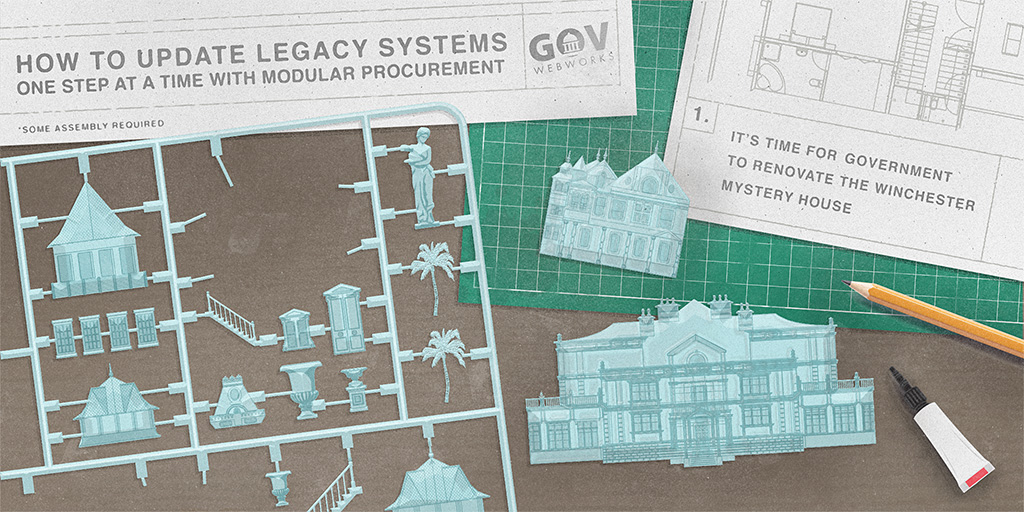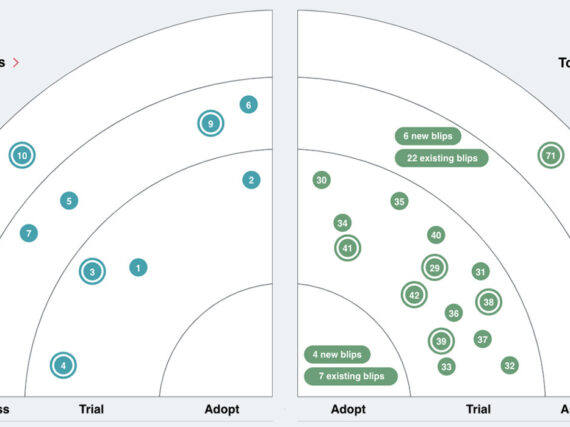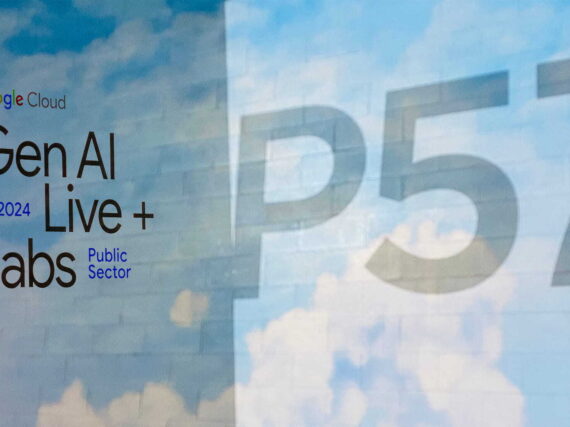Much like the Winchester Mystery House, our government is living in an ever expanding, and unwieldy software mansion befit with numerous legacy systems and patches. These old, but mostly functional systems cost a fortune to maintain and often lack the desired functionality and interoperability needed by government agencies.
To add insult to injury, these systems are relics of the past compared to modern software applications. They barely meet citizen needs, and are far from the modern, innovative landscape that government would love to inhabit. There is a growing realization that this situation is unsustainable.
Approximately 70% of the IT budget for the US government is spent on legacy system maintenance. This number is often higher for state and local governments. These are resources which could be added to the approximately 20% of the IT budget that is spent on development, modernization, and enhancements.
We think it’s time to remodel the Winchester House of government technology systems.
What’s so bad about living in an old house/system?
For those who are unfamiliar, the Winchester Mystery House in San Jose, California, is the former residence of Sarah Winchester, the widow of the gun magnate William Winchester. Fueled by superstition, Mrs. Winchester plowed a fortune into the continuous building of this complex until her death. This sprawling mansion has no master plan and is consequently host to multiple architectural styles and oddities: doors and stairs that go nowhere, windows overlooking other rooms, and stairwells with odd-sized risers.
A badly designed system, like a badly designed house (or one which has morphed uncontrollably over time), may be ‘livable’ and possess a certain amount of charm, but certainly isn’t ideal. Things break, repairs are more costly, and we learn to live in a sub-optimal environment instead of demanding better.
However, the option of moving to a new house, like moving systems, is disruptive, requiring huge commitments of time, money, and opportunity costs. There is comfort in the familiar, yet the familiar is also the enemy of progress.
The following challenges may contribute to the issue:
- Managers are reluctant or unable to give up precious resources to move to a new system
- Departments may be so used to the decaying but still semi-functional system that they are unwilling to change, especially if it means intensive training and expense
- Sometimes a new system is overly expensive, and a simple update will do for now
The Winchester House of government data
Unwieldy legacy systems are especially an issue in government record keeping. While government entities may be legally required to keep such records, there isn’t enough justification to replace the system when so many other higher profile applications need attention. Consequently:
- Government entities own obsolete hardware and connectors which are difficult to replace and maintain, drastically increasing the cost of ownership
- Resources are sacrificed to maintain a status quo, while the risks of system failure and retiring of user knowledge increases
- Security issues abound
The primary issue is that some legacy systems are run on a nearly 60 year old programming language called Common Business-Oriented Language (COBOL), for which programers are in short supply. The longer these systems gather dust, the harder it is to transfer data.
Keeping the lights on
For example, in Maine, Application Support has responsibility for some 600 different application systems. About 85% of the state’s efforts are dedicated to operating and maintaining the legacy applications, that is to say “keeping the lights on.” The balance of activity is applied to new initiatives which include modernization of old applications, and to a lessor degree, new functionality. The state has applications as old as 40 years of age, with the average being around 15. The older an application, the higher the maintenance cost and more expensive it is to adapt to changing agency needs.
It’s easy to blame the technology leaders in charge, but the truth is, these leaders are often placed in an unenviable and difficult position. Severely understaffed, underfunded, and under appreciated, they want to innovate, but don’t have adequate resources or support to do so. They are forced to have one foot in the past to prevent further crumbling of old but essential systems. They must also have one foot in the future as industry leaders and visionaries, championing the way for new systems that better meet the needs of those they serve.
How to move forward?
States want to let go of the ghosts of the past and move out of the Winchester House, but they often lack the resources to build a new system from the ground up. This is why we believe renovating one room at a time to be an easier and more realistic approach.
We agree with entities such as 18F, who advocate for a modular approach to procurement, which means updating one new system at a time, rather that overhauling everything at once. Additionally, we support best practices, such as agile software development, which allows for transparent progress to be made on the ‘renovations’ very quickly.
The modernization movement is catching on around the country. Here are some ways to join in:
- Investigate: Take an honest look at the systems in place. What is necessary for the delivery of modern government services, what can remain with minor updates, and what can go?
- Define: Architect a plan/vision for home improvements, ‘a renovated estate’ instead of the ‘sprawling mansion’
- Partner: Get help moving on by involving the private sector early in the planning stages for guidance
In government, as in the private sector, proper planning is essential for a successful outcome. The following best practices are advised:
- Essential stakeholders should be involved early on – while gathering consensus may take time, it will ultimately make the planning, procurement, and implementation process smoother and more successful
- Having a project champion, or ‘architect,’ (a group or person) to own and ‘sell’ the long term vision will help
- Using flexible, smaller contracts to tackle the various project phases in an modular way (perhaps with a pre-qualified vendor list) is another great strategy
An incremental solution
Replacing the whole mansion at once would be costly and time consuming. It would also leave government services homeless, and departments unable to function. Many of the older technologies are still needed and useable, even though they may not be as efficient or desirable as newer technologies on the market today. Other features of the ‘house’ are obsolete and need to be discarded. Think outdoor plumbing and lead-based paint (or non-replaceable hardware and standalone legacy systems).
Modular procurement makes it easier to redo one room (system) at a time, from a new finance, record keeping, or case management system, to a new database or user interface.
Continuing the housing analogy, each new room would also be upgraded to be ADA compliant, aesthetically pleasing, and energy efficient (in the case of new technology, 508 compliant, user friendly, and easy to maintain). This modular approach is favored by those at the Brookings Institute and others.
Now is the time to act
The need to update these decaying software mansions is made even more critical due to the discrepancies between legacy systems and the newer, more efficient and less expensive technologies. Furthermore:
- The need for patches is expensive and time consuming and those skilled in older programming languages are nearing retirement age
- Modern software is often better designed, more user friendly, and flexible (ie: open source technology such as Drupal is highly efficient and widely used in the Federal government)
- Current technology implemented in a modular/Agile way allows for cost containment, increased accountability, greater interoperability, and faster adaption to future citizen needs
The longer government procrastinates, the more grave the situation becomes. In my experience, while moving to a new home or remodeling can be a challenging experience, the benefits of this change often far outweigh the hassle of the process.
In conclusion
To meet the needs of modern government, more support is needed for our government leaders. They must be able to demonstrate a clear and meaningful vision of service delivery and create a manageable blueprint for a remodeled home. As stated above, we recommend the following best practices to achieve this vision:
- Breaking up large technology procurement into smaller, modular procurement contracts
- Using cloud based technologies and an agile approach to software development
- Focusing on user centric, mobile friendly, and intuitive design to meet modern expectations
Whether it is fear of change, political backlash, or budget constraints, being stuck in the old Winchester Mystery House with its maze of rooms, oddities, and ghosts is less than ideal. Governments need support as they plan for, and begin modernization of the house before it crumbles.
Learn more
- Government spending statistics from It Dashboard
- Why Manual Accessibility Testing Matters
- Four Cs for Flawless Agile Business Requirements
- More about Drupal
- Information Technology in Maine State Government – 2016 Annual Report
- Pulling back the curtain on IT procurement
- Doomed: Challenges and solutions to government IT projects







